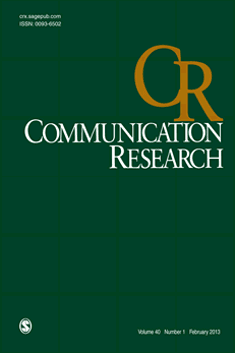
COMMUNICATION RESEARCH
Scope & Guideline
Elevating Scholarship in Communication Studies.
Introduction
Aims and Scopes
- Theoretical Frameworks in Communication:
The journal emphasizes the development and critique of theoretical frameworks that explain communication phenomena, including interpersonal, organizational, and mediated communication. - Empirical Research on Media and Society:
A core focus is on empirical studies that investigate the role of media in shaping public perceptions, behaviors, and societal dynamics, particularly in the context of digital and social media. - Interpersonal and Intergroup Communication:
Research exploring interpersonal dynamics, including relational communication, conflict resolution, and identity negotiation within and between groups, is a significant area of interest. - Health Communication:
The journal addresses health communication strategies, effects of media on health behaviors, and the role of communication in public health initiatives, reflecting the growing intersection of media and health. - Political Communication:
Political communication research is central to the journal, focusing on media influence on public opinion, political behavior, and the dynamics of political discourse in various media environments. - Diversity and Inclusion in Communication:
The journal is committed to exploring issues related to diversity, equity, and inclusion in communication practices, examining how identity factors influence communication experiences. - Technology and Communication:
Investigating the impact of emerging technologies on communication practices, including the effects of artificial intelligence, social media algorithms, and digital platforms, is a prominent theme.
Trending and Emerging
- Digital Communication and Online Behavior:
A growing emphasis on understanding how digital communication platforms influence social interaction, information dissemination, and audience engagement reflects the importance of online behavior in contemporary society. - Mental Health and Well-Being:
Research is increasingly focusing on the interplay between communication practices and mental health outcomes, particularly in the context of social media and digital interactions. - Algorithmic Influence and Media Literacy:
As algorithms shape content delivery on social media, studies examining their effects on public perception and consumption patterns are on the rise, highlighting the need for media literacy. - Political Polarization and Discourse:
The analysis of political communication amid increasing polarization is trending, with researchers exploring how media framing and discourse shape political attitudes and behaviors. - Crisis Communication and Public Health:
The COVID-19 pandemic has catalyzed research on crisis communication strategies, particularly in public health contexts, emphasizing the role of communication in managing societal responses. - Identity and Representation in Media:
Emerging themes focus on how various identities are represented in media and communication, exploring issues of race, gender, and sexuality, and their implications for social justice. - Interdisciplinary Approaches to Communication:
There is a noticeable trend towards interdisciplinary research that integrates insights from psychology, sociology, and technology studies to enrich communication research.
Declining or Waning
- Traditional Media Studies:
Research focusing solely on traditional media formats, such as print newspapers and broadcast television, is becoming less prevalent as the focus shifts toward digital media and online platforms. - One-Dimensional Audience Studies:
Studies that treat audiences as passive recipients of media messages without considering their active role in media engagement and content creation are declining in favor of more nuanced audience analyses. - Static Models of Communication:
The use of static models that do not account for the dynamic and evolving nature of communication processes, especially in digital contexts, is waning as scholars seek more adaptable frameworks. - Homogeneous Research Samples:
There is a noticeable decrease in studies relying on homogeneous samples, as the field increasingly values diversity in research participants to better reflect the complexities of communication. - Overly Generalized Findings:
Research outputs that lack specificity and fail to address contextual variations in communication practices are receiving less attention, as the field moves towards more context-sensitive analyses.
Similar Journals

Communications-European Journal of Communication Research
Advancing the Frontiers of Communication ResearchCommunications-European Journal of Communication Research is a premier journal published by DE GRUYTER MOUTON, dedicated to fostering scholarly discourse in the field of communication studies. With a publication history spanning over four decades, from 1976 through to 2024, this journal serves as a vital resource for researchers and practitioners interested in the latest advancements and theoretical developments in communication. The journal is recognized for its rigorous peer-review process and has earned a commendable reputation, evidenced by its ranking in the Q2 quartile in both Arts and Humanities (miscellaneous) and Communication categories for 2023. Its Scopus rankings signify its relevance and impact, positioning it within the top quartile of the discipline's literature. Although not an open access journal, it provides access to a wide range of research that contributes significantly to the understanding of communication practices across diverse contexts. Scholars, professionals, and students alike will find a wealth of knowledge that not only sharpens their academic pursuits but also enriches practical applications in the communication landscape.
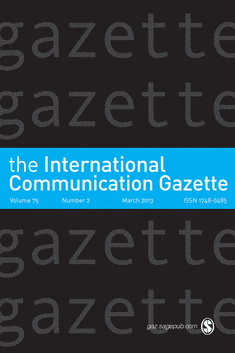
International Communication Gazette
Fostering Scholarly Dialogue in International CommunicationThe International Communication Gazette is a prestigious academic journal published by SAGE Publications Inc. that has been at the forefront of communication studies since its inception in 1961. With a focus on interdisciplinary research, this journal aims to explore the ever-evolving landscape of communication within the contexts of sociology and political science. Ranking in the top quartile (Q1) in both the Communication and Sociology & Political Science fields, it offers significant insights into current trends and theories, making it a vital resource for researchers, professionals, and students alike. The journal holds a commendable position in Scopus rankings, standing at #82 out of 511 in Communication and #245 out of 1466 in Sociology and Political Science, reflecting its impact and relevance in the scholarly community. Although it is not an open-access journal, the International Communication Gazette remains committed to disseminating high-quality, peer-reviewed research that sparks discussions and furthers understanding in the dynamic world of global communication.
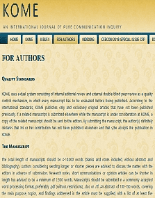
KOME-An International Journal of Pure Communication Inquiry
Engaging Minds, Transforming Communication UnderstandingKOME-An International Journal of Pure Communication Inquiry is a scholarly journal published by Ludovika University Press in Hungary, dedicated to advancing the study and understanding of communication across various contexts. Since its inception in 2012 as an open-access journal, KOME aims to foster a vibrant dialogue among researchers, professionals, and students by providing a platform for innovative research in the fields of Communication and Linguistics. With its recent classification as a Q3 journal in Communication and Q2 in Linguistics and Language, KOME stands out as a valuable resource, ranking in the 70th percentile for Linguistics and Language and 47th percentile for Communication in Scopus. Researchers are encouraged to submit original articles, reviews, and case studies that contribute to the evolving discourse on pure communication inquiries. Located at Ludovika ter 2, Budapest, this journal not only promotes academic excellence but also ensures that scholarly works are accessible to a global audience, reinforcing the importance of communication studies in our interconnected world.

COMMUNICATION MONOGRAPHS
Fostering rigorous inquiry in the heart of communication studies.COMMUNICATION MONOGRAPHS is a premier peer-reviewed journal published by Routledge Journals, Taylor & Francis Ltd, dedicated to advancing the field of communication studies. With roots dating back to 1976, this esteemed publication reflects the dynamic and evolving landscape of communication research and theory, contributing significantly to both the Communication and Linguistics disciplines. Holding a prestigious Q1 ranking in both categories for 2023, the journal is recognized for its high impact and rigorous scholarship, as evidenced by its exceptional Scopus rankings, which place it in the 96th and 87th percentiles in Language and Linguistics and Communication respectively. While COMMUNICATION MONOGRAPHS does not offer open access options, it remains an authoritative source for academics, professionals, and students seeking to deepen their understanding of communication phenomena. Situated in the United Kingdom, this journal continues to be pivotal in shaping contemporary discourse and research agendas in the fields it encompasses.

International Journal of Strategic Communication
Exploring the Nexus of Communication and Strategy.International Journal of Strategic Communication, published by Taylor & Francis Ltd, is a premier journal dedicated to advancing the field of communication studies, particularly in the strategic domain. With an ISSN of 1553-118X and an E-ISSN of 1553-1198, this journal has established itself as a vital resource for researchers, professionals, and students engaged in the intricate interplay between communication, sociology, and political science. Ranked in the Q2 quartile in both Communication and Sociology & Political Science categories and placed in the 76th percentile in Scopus rankings, it attracts high-quality submissions that contribute to the understanding of strategic communication within various contexts. Since its convergence in 2010, the journal aims to publish innovative research that not only enriches theoretical frameworks but also informs practical applications. With its commitment to rigorous scholarship and real-world relevance, the International Journal of Strategic Communication remains a cornerstone for those looking to explore contemporary challenges and opportunities in the field.
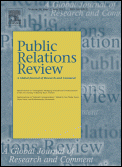
PUBLIC RELATIONS REVIEW
Fostering Knowledge at the Intersection of Theory and Practice.PUBLIC RELATIONS REVIEW, published by Elsevier Science Inc, stands as a premier academic journal dedicated to advancing the field of public relations, marketing, and organizational communication. With an impressive impact factor and a distinguished track record since its inception in 1975, this journal has consistently ranked in the Q1 quartile for its categories, showcasing its critical role in scholarly discourse. The journal, which operates without Open Access options, offers insightful articles that blend theoretical frameworks with practical applications, making it an essential resource for researchers, professionals, and students alike. Its authoritative coverage in areas like communication, organizational behavior, and marketing is evidenced by its high Scopus rankings, placing it among the top percentile of journals in these fields. As the landscape of public relations continues to evolve, PUBLIC RELATIONS REVIEW remains at the forefront of scholarship, providing a vital platform for innovative research and discussions that shape industry practices and academic understanding.
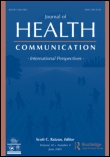
JOURNAL OF HEALTH COMMUNICATION
Elevating Conversations, Enhancing Health OutcomesJOURNAL OF HEALTH COMMUNICATION, published by Taylor & Francis Inc, stands at the forefront of research in the interdisciplinary field of health communication, a vital area in today’s healthcare landscape. With an impressive 2023 impact factor reflecting its influence and prestige, this journal is recognized in the top quartile (Q1) across multiple categories, including Communication, Health (Social Science), Library and Information Sciences, and Public Health, Environmental and Occupational Health. This accolade highlights the journal's engagement with key issues in health communication, making it a crucial resource for researchers, professionals, and students dedicated to improving health outcomes through effective communication strategies. The journal covers a wide range of topics from health literacy to media advocacy and public health messaging, providing a platform for innovative research that shapes health policies and practices globally. Published continuously since 1996, the Journal of Health Communication remains committed to fostering knowledge and engagement in the health communication discipline.

Review of Communication Research
Empowering Voices in Scholarly DiscourseReview of Communication Research is a prestigious open-access journal dedicated to advancing the field of communication studies. Published by REVIEW COMMUNICATION RESEARCH from its base in Madrid, Spain, this journal has established itself as a vital platform for scholarly discourse since its inception. With an impressive impact factor and ranked in the Q1 quartile of communication journals for 2023, it holds a commendable position, placing it within the top 13% of approximately 511 journals in the communication category on Scopus. Since becoming open-access in 2013, the journal has enabled researchers, professionals, and students to access high-quality research without financial barriers, thereby fostering a greater dissemination of knowledge and dialogue within the community. Covering a wide array of topics from communication theory to media studies, the Review of Communication Research continues to contribute significantly to the understanding and evolution of communication in today’s interconnected world. Researchers are encouraged to engage with and submit their findings to this influential journal to further enrich the scholarly landscape.

Tripodos
Unveiling Insights in Contemporary CommunicationTripodos is a prominent open-access journal published by UNIV RAMON LLULL, FAC CIENCIES COMUNICACIO BLANQUERNA in Spain, dedicated to advancing the field of communication studies since its establishment. With an ISSN of 1138-3305 and an E-ISSN of 2340-5007, Tripodos has gained recognition for publishing high-quality research articles that examine diverse aspects of communication in contemporary society. The journal has successfully transitioned to open access since 2006, ensuring that its valuable contributions are readily available to a global audience. As of 2023, Tripodos holds a Q3 ranking in the Communication category according to Scopus, reflecting its growing influence within the academic community, ranking 187 out of 511 journals and positioning itself in the 63rd percentile. This journal serves as an essential platform for researchers, professionals, and students who are eager to explore the dynamic field of communication and its impact on society.

Frontiers in Communication
Shaping Tomorrow's Conversations TodayFrontiers in Communication is a prestigious open-access journal published by FRONTIERS MEDIA SA, dedicated to advancing the field of communication studies. Established in 2016 and situated in Switzerland, this journal has quickly ascended to notable ranks, achieving a Q1 category in both Communication and Social Sciences (miscellaneous) as of 2023. With an impressive Scopus rank, positioning it in the 75th and 78th percentiles for its respective categories, Frontiers in Communication serves as a vital platform for innovative research, interdisciplinary dialogue, and the dissemination of knowledge in the rapidly evolving landscape of communication. The journal emphasizes accessibility and intellectual exchange, providing an open-access format that ensures unrestricted access for researchers, professionals, and students alike. By fostering collaboration and exploration across various communication frameworks, Frontiers in Communication plays a crucial role in shaping the future discourse within the field.